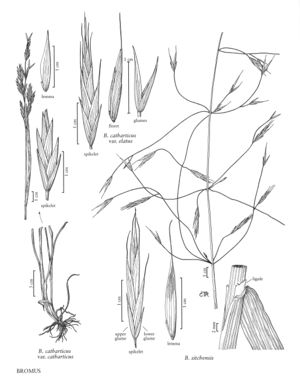Difference between revisions of "Bromus sitchensis"
FNA>Volume Importer |
FNA>Volume Importer |
||
| Line 17: | Line 17: | ||
-->{{Treatment/Body | -->{{Treatment/Body | ||
|distribution=Oreg.;Alaska;Calif.;Wash.;B.C. | |distribution=Oreg.;Alaska;Calif.;Wash.;B.C. | ||
| − | |discussion=<p>Bromus sitchensis grows on exposed rock bluffs and cliffs, and in meadows, often in the partial shade of forests along the ocean edge, and on road verges and other disturbed sites. Its range extends from the Aleutian Islands and Alaska panhandle through British Columbia to southern California.</p><!-- | + | |discussion=<p><i>Bromus sitchensis</i> grows on exposed rock bluffs and cliffs, and in meadows, often in the partial shade of forests along the ocean edge, and on road verges and other disturbed sites. Its range extends from the Aleutian Islands and Alaska panhandle through British Columbia to southern California.</p><!-- |
| − | --><p>Bromus sitchensis resembles B. aleutensis, the two sometimes being treated as conspecific varieties. Bromus sitchensis is predominantly outcrossing, while B. aleutensis is predominantly self-fertilizing (C.L. Hitchcock 1969).</p> | + | --><p><i>Bromus sitchensis</i> resembles <i>B. aleutensis</i>, the two sometimes being treated as conspecific varieties. <i>Bromus sitchensis</i> is predominantly outcrossing, while <i>B. aleutensis</i> is predominantly self-fertilizing (C.L. Hitchcock 1969).</p> |
|tables= | |tables= | ||
|references= | |references= | ||
| Line 39: | Line 39: | ||
|publication year= | |publication year= | ||
|special status= | |special status= | ||
| − | |source xml=https://jpend@bitbucket.org/aafc-mbb/fna-data-curation.git/src/ | + | |source xml=https://jpend@bitbucket.org/aafc-mbb/fna-data-curation.git/src/8f726806613d60c220dc4493de13607dd3150896/coarse_grained_fna_xml/V24/V24_276.xml |
|subfamily=Poaceae subfam. Pooideae | |subfamily=Poaceae subfam. Pooideae | ||
|tribe=Poaceae tribe Bromeae | |tribe=Poaceae tribe Bromeae | ||
Revision as of 16:18, 18 September 2019
Plants perennial; loosely ces¬pitose. Culms 120-180 cm tall, 3-5 mm thick, erect. Sheaths glabrous or sparsely pilose; auricles absent; ligules 3-4 mm, glabrous or hairy, obtuse, lacerate; blades 20^40 cm long, 2-9 mm wide, flat, sparsely pilose adaxially or on both surfaces. Panicles 25-35 cm, open; lower branches to 20 cm, 2-4(6) per node, spreading, often drooping, with 1-3 spikelets on the distal 1/2 sometimes confined to the tips. Spikelets 18-38 mm, elliptic to lanceolate, strongly laterally compressed, with (5)6-9 florets. Glumes glabrous, sometimes scabrous; lower glumes 6-10 mm, 3-5-veined; upper glumes 8-11 mm, 5-7-veined; lemmas 12-14(15) mm, lanceolate, laterally compressed, 7-11-veined, strongly keeled at least distally, usually glabrous, sometimes hirtellous, margins sometimes sparsely pilose, apices entire or with acute teeth, teeth shorter than 1 mm; awns 5-10 mm; anthers to 6 mm. 2n = 42, 56.
Distribution
Oreg., Alaska, Calif., Wash., B.C.
Discussion
Bromus sitchensis grows on exposed rock bluffs and cliffs, and in meadows, often in the partial shade of forests along the ocean edge, and on road verges and other disturbed sites. Its range extends from the Aleutian Islands and Alaska panhandle through British Columbia to southern California.
Bromus sitchensis resembles B. aleutensis, the two sometimes being treated as conspecific varieties. Bromus sitchensis is predominantly outcrossing, while B. aleutensis is predominantly self-fertilizing (C.L. Hitchcock 1969).
Selected References
None.
